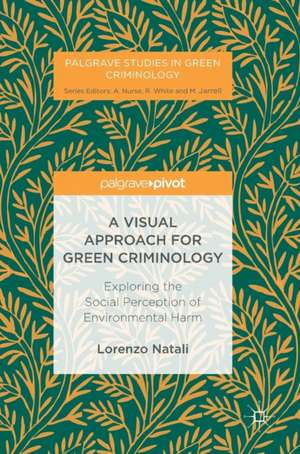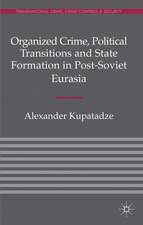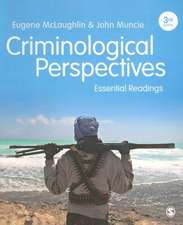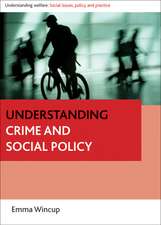A Visual Approach for Green Criminology: Exploring the Social Perception of Environmental Harm: Palgrave Studies in Green Criminology
Autor Lorenzo Natalien Limba Engleză Hardback – 28 noi 2016
This book brings the visual dimension of environmental crimes and harms into the field of green criminology. It shows how photographic images can provide a means for eliciting narratives from people who live in polluted areas – describing in detail and from their point of view what they know, think and feel about the reality in which they find themselves living.
Natali makes the argument for developing a visual approach for green criminology, with a single case-study as its central focus, revealing the importance of using photo elicitation to appreciate and enhance the reflexive and active role of social actors in the symbolic and social construction of their environmental experiences. Examining the multiple interactions between the images and the words used to describe the socio-environmental worlds in which we live, this book is a call to open the eyes of green criminology to wider and richer explorations of environmental harms and crimes. An innovative and engaging study, this text will be of particular interest to scholars of environmental crime and cultural, green and visual criminologies.
Din seria Palgrave Studies in Green Criminology
-
 Preț: 319.35 lei
Preț: 319.35 lei -
 Preț: 386.22 lei
Preț: 386.22 lei - 15%
 Preț: 642.18 lei
Preț: 642.18 lei - 18%
 Preț: 782.42 lei
Preț: 782.42 lei - 18%
 Preț: 891.48 lei
Preț: 891.48 lei - 18%
 Preț: 948.79 lei
Preț: 948.79 lei - 15%
 Preț: 645.96 lei
Preț: 645.96 lei - 15%
 Preț: 648.24 lei
Preț: 648.24 lei - 18%
 Preț: 894.79 lei
Preț: 894.79 lei - 18%
 Preț: 944.82 lei
Preț: 944.82 lei - 15%
 Preț: 577.72 lei
Preț: 577.72 lei - 15%
 Preț: 637.13 lei
Preț: 637.13 lei - 18%
 Preț: 888.49 lei
Preț: 888.49 lei - 18%
 Preț: 895.45 lei
Preț: 895.45 lei - 18%
 Preț: 724.00 lei
Preț: 724.00 lei - 18%
 Preț: 949.73 lei
Preț: 949.73 lei - 15%
 Preț: 696.82 lei
Preț: 696.82 lei -
 Preț: 382.75 lei
Preț: 382.75 lei - 18%
 Preț: 945.14 lei
Preț: 945.14 lei
Preț: 451.26 lei
Nou
Puncte Express: 677
Preț estimativ în valută:
86.36€ • 93.77$ • 72.54£
86.36€ • 93.77$ • 72.54£
Carte tipărită la comandă
Livrare economică 22 aprilie-06 mai
Preluare comenzi: 021 569.72.76
Specificații
ISBN-13: 9781137546678
ISBN-10: 1137546670
Pagini: 144
Ilustrații: XV, 137 p. 14 illus.
Dimensiuni: 148 x 210 x 11 mm
Greutate: 0.34 kg
Ediția:1st ed. 2016
Editura: Palgrave Macmillan UK
Colecția Palgrave Pivot
Seria Palgrave Studies in Green Criminology
Locul publicării:London, United Kingdom
ISBN-10: 1137546670
Pagini: 144
Ilustrații: XV, 137 p. 14 illus.
Dimensiuni: 148 x 210 x 11 mm
Greutate: 0.34 kg
Ediția:1st ed. 2016
Editura: Palgrave Macmillan UK
Colecția Palgrave Pivot
Seria Palgrave Studies in Green Criminology
Locul publicării:London, United Kingdom
Cuprins
1. Green Criminology with Eyes Wide Open.- 2. A Case of Organic Relationship between City and Contamination.- 3. Ways of Looking at the Elephant in the Room.- 4. Ways of Seeing the Elephant in the Room.- 5. What Do You Mean When You Show and Say This?.- 6. Imaging Visual Methods for Green Criminology.- 7. Conclusion
Notă biografică
Lorenzo Natali holds a PhD in Criminal Law and Criminology and is currently a post-doctoral Fellow at the Department of Sociology and Social Research, University of Milano-Bicocca, Italy. His research focuses on violent crime, symbolic and radical interactionism, green criminology, and qualitative and interdisciplinary approaches, including visual methodologies. He is the author of Green Criminology: Prospettive Emergenti sui Crimini Ambientali (Torino: Giappichelli).
Textul de pe ultima copertă
This book brings the visual dimension of environmental crimes and harms into the field of green criminology. It shows how photographic images can provide a means for eliciting narratives from people who live in polluted areas – describing in detail and from their point of view what they know, think and feel about the reality in which they find themselves living.
Natali makes the argument for developing a visual approach for green criminology, with a single case-study as its central focus, revealing the importance of using photo elicitation to appreciate and enhance the reflexive and active role of social actors in the symbolic and social construction of their environmental experiences. Examining the multiple interactions between the images and the words used to describe the socio-environmental worlds in which we live, this book is a call to open the eyes of green criminology to wider and richer explorations of environmental harms and crimes. An innovative and engaging study, this text will be of particular interest to scholars of environmental crime and cultural, green and visual criminologies.
Lorenzo Natali holds a PhD in Criminal Law and Criminology and is currently a post-doctoral Fellow at the Department of Sociology and Social Research, University of Milano-Bicocca, Italy. His research focuses on violent crime, symbolic and radical interactionism, green criminology, and qualitative and interdisciplinary approaches, including visual methodologies. He is the author of Green Criminology: Prospettive Emergenti sui Crimini Ambientali (Torino: Giappichelli).
Natali makes the argument for developing a visual approach for green criminology, with a single case-study as its central focus, revealing the importance of using photo elicitation to appreciate and enhance the reflexive and active role of social actors in the symbolic and social construction of their environmental experiences. Examining the multiple interactions between the images and the words used to describe the socio-environmental worlds in which we live, this book is a call to open the eyes of green criminology to wider and richer explorations of environmental harms and crimes. An innovative and engaging study, this text will be of particular interest to scholars of environmental crime and cultural, green and visual criminologies.
Lorenzo Natali holds a PhD in Criminal Law and Criminology and is currently a post-doctoral Fellow at the Department of Sociology and Social Research, University of Milano-Bicocca, Italy. His research focuses on violent crime, symbolic and radical interactionism, green criminology, and qualitative and interdisciplinary approaches, including visual methodologies. He is the author of Green Criminology: Prospettive Emergenti sui Crimini Ambientali (Torino: Giappichelli).
Caracteristici
Develops the notion of photo elicitation as a useful tool in appreciating social factors affecting environmental issues Provides an interdisciplinary argument for the need for a visual dimension when assessing environmental crime Offers an in-depth analysis of a single case study with a specific focus
















